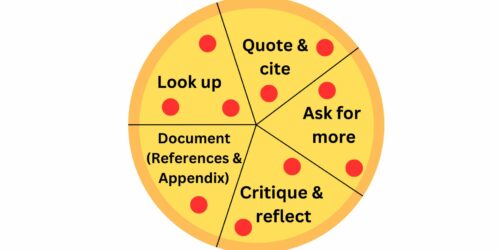Student Authors and AI Writing Tools
By Elan Paulson and Ada Sharpe
The Idea of Author

In the West, the word author refers to someone who expresses their unique perspective and voice in their writing. Authors are the creators of “original work,” and they bear responsibility for the work they have created (Baldick, 2001). This idea of the author informs modern Western legal, cultural, and educational practices related to authorship.
At the College, learning outcomes may require students to develop their own ideas and voices as an author. Students use standardized style guides to cite other authors’ words and ideas. As well, students practice and improve their writing, including use of tools to assist writing.
Authorship Changes with New Writing Tools
A number of emergent writing tools (e.g., speech recognition tools, such as Dragon) were developed initially to support people with disabilities (Power, 2019). Such technology now provides digitization, processing, storage, and predictive functions that enhance how and what authors write (Valentine, 2012). Recent artificial intelligence (AI) writing tools, such as ChatGPT, provide not only automatic writing evaluation but also outputs of writing.
These tools shift how we understand authorship, especially in education:
- How do we compare what emerging writing technology does with what student authors do?
- How do AI writing tools affect how students see themselves as authors?
Generative AI vs Humans as Authors
As described in Chat GPT and the Evolving Field of Artificial Intelligence, AI can be prompted to generate a wide range of human-like writing. At the time of this post, however, ChatGPT doesn’t fact check, search the real-time internet, reference texts after 2021, or source quotations with accuracy. Generative AI writing tools simulate, but do not replicate, human writing processes; the outputs only compile and combine prior writing based on recognized patterns and algorithms.
In contrast, human authors have empathy, self-knowledge, intuition, lived experiences, and the ability to create new ideas. Human authors can reflect on the self and the self’s experience. They can assess with precision the contexts and the circumstances in which people communicate and the multiple variables involved (such as purpose, audience, topic, etc.). Despite the increased capacity of AI writing tools to enhance writing, some aspects of writing remain uniquely human.
Encouraging Learning and Students’ Human Voice as Authors

If your course learning goals include developing students’ voice and skills as an author, then it is vital to help students to understand how and why human authorship matters (and what is at risk when authors rely too much on AI outputs).
Here are some ideas for encouraging students to see where and how their voice matters in course-related writing.
Set academic integrity norms and expectations
You can discuss your expectations for students regarding what types of writing tools may be used in writing activities. For example, you may clarify that students may use Grammarly for editing but should avoid ChatGPT. Support this requirement by asking for a performance report.
You can also ask students to integrate the words of other authors and to use appropriate style guides for citing and sourcing those references. Support this requirement by evaluating the use of a style guide.
Appeal to integrity and professional practice
You might discuss with students the impact or potential adverse effects of writing generated by AI tools in your field or industry. For instance, you may wish to reference your industry’s professional standards, certifications or employee credibility, or any legal implications.
Practice self-expression in speaking activities
In low-stakes practice activities, you can encourage students to articulate an opinion or take a stance on an issue. This activity encourages students to build confidence in communicating their ideas. For example, have students practice speaking from their position and contexts in short speaking activities during lessons.
Consider the value of (human) authorship in your field or industry
It may be helpful to look at different types of writing in your industry and who are its expert authors. You can explore a selection of expert “voices” of authors in your field and consider the value of that unique voice for that author’s brand, notoriety, or credibility.
Use in-class guided writing activities
You can encourage students to express their voices as a human author. For example, ask students to describe the learning process using details from their unique experiences. Or, you can give students a specific case or scenario and ask that students write a response from their own position and lived experience.
Foster metacognition through written reflection
You might encourage students to reflect (make their writing process explicit) on their growth following a learning experience or challenge in writing. For example, have students apply course-specific concepts to personal experiences. Or, you might encourage written reflection on how the experience of writing or presenting information enhanced their thinking and skills in writing. Did students have to interpret new perspectives or consider new evidence?
Help build students’ digital literacy
Discuss with students the limitations of generative AI, namely that it does “not engage in critical thinking, personalized reflection, interpretation, complex problem-solving, or context-specific applications of course material” (Crowdsourcing,” n.d.).
You can do this by asking students to do a “fact check” or a “reference check” of the text and references generated by AI writing tools.
Summary
Currently, there are security risks and safety concerns in using ChatGPT and other AI tools in course-related writing activities (Getahun, 2023, n.p.). Consequently, at this time you are encouraged to avoid requiring students to use third-party generative AI tools, submitting College IP to third-party AI tools, and submitting student work to AI checkers.
Generative AI tools have many writing capabilities, but they lack humans’ creative and critical abilities. To build student confidence and competence as authors, you may wish to provide writing activities that engage students in writing about self-knowledge and their specific experiences and writing contexts.
This post was reviewed using Grammarly.
References
Baldick, C. (2001). A Concise Dictionary of Literary Terms: Vol. 2nd ed. Oxford University Press.
Getahun, H. (2023 12 Feb). Breaking ChatGPT: The AI’s alter ego DAN reveals why the internet is so drawn to making the chatbot violate its own rules. Business Insider.
Power, R. (Ed.). (2019). Technology and the curriculum. Pressbooks.
Valentine, P.M. (2012). A social history of books and libraries from cuneiform to bytes. The Scarecrow Press.



